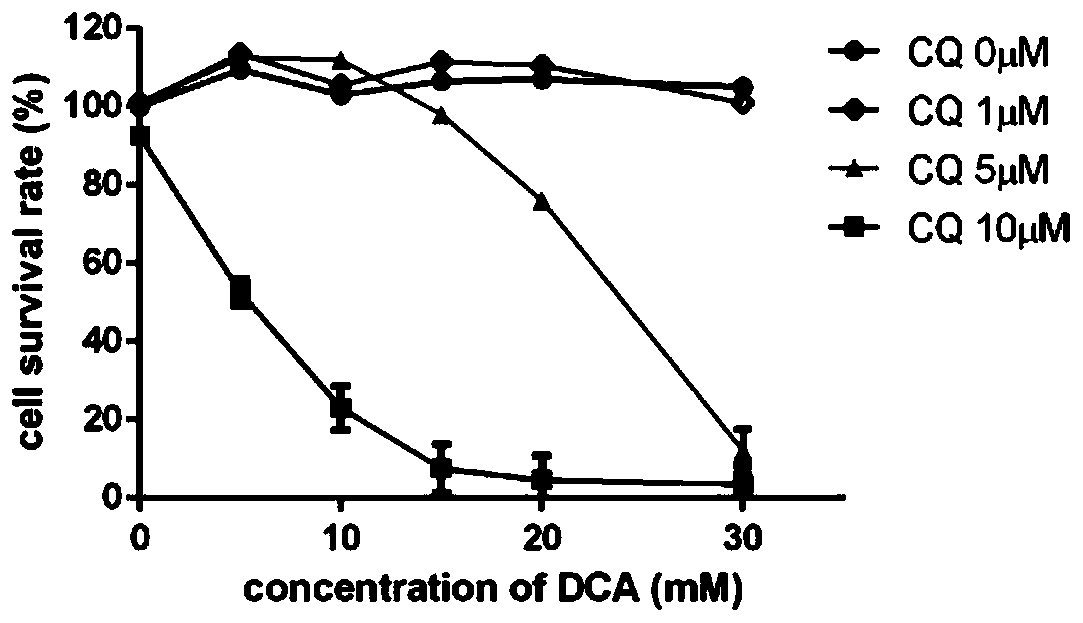Pharmaceutical composition and application thereof in preparation of medicaments for treating tumors
A technology of tumor drugs and compositions, applied in the field of biomedicine, can solve the problems of unimproved survival of patients, poor effect of monoclonal antibodies, and limited effect of monoclonal antibodies, etc., to improve tumor cell metabolism, inhibit tumor cell proliferation, inhibit The effect of neovascularization
- Summary
- Abstract
- Description
- Claims
- Application Information
AI Technical Summary
Problems solved by technology
Method used
Image
Examples
Embodiment 1
[0039] To verify the toxic effect of sodium dichloroacetate and chloroquine on tumor cells, the test is as follows: Human colon cancer HCT116, human breast cancer MCF7, and human liver cancer HepG2 cells derived from ATCC in the United States were cultured in DMEM containing 10% fetal bovine serum to 90% Digest and subculture with 0.25% trypsin when confluent, and subculture once every 3-5 days. 20,000 cells were planted in wells of 96-well cell culture plates and cultured overnight at 37°C. Different concentrations of sodium dichloroacetate and chloroquine were added to culture for 5 days (renewed once a day). On the 6th day, the cell viability was detected according to the MTS kit (Promega Company). As a result, it can be seen that with the increase of the concentration, sodium dichloroacetate and chloroquine are used in combination on HCT116 ( figure 1 ), MCF7 ( figure 2 ) and HepG2 ( image 3 ) produced a significant toxic effect, and the two drugs had a significant s...
Embodiment 2
[0041] To verify the significant cytotoxic effect of sodium dichloroacetate, chloroquine and integrin siRNA on HepG2 cells, the test is as follows: 40,000 human liver cancer HepG2 cells were planted in 96-well cell culture plate wells, and cultured overnight at 37°C. Then, Lipofectamine RNAiMAX was used to transfect integrin β5 (ITGB5) and β3 (ITGB3) siRNA (0.3nmol / well) for 48 hours, then added different concentrations of sodium dichloroacetate and chloroquine and cultured for 3 days (renewed once a day). On the 6th day, the cell viability was detected according to the MTS kit (Promega Company). In this embodiment, the cell seeding density was doubled compared to Example 1, and it can be seen that the three combined use of HepG2 cells ( Figure 4 ) produced significant toxic effects, and with the increase of sodium dichloroacetate and chloroquine concentrations, the cytotoxic effects were strengthened.
Embodiment 3
[0043] Sodium dichloroacetate and chloroquine combined inhibit HepG2 cell colony formation test, the method is as follows: HepG2 cells in the logarithmic growth phase were digested and counted, and 2500 cells / well were drawn and inoculated into a 6-well cell culture plate. After culturing for 24 hours, add 10 mM sodium dichloroacetate, 10 μM chloroquine or 10 mM sodium dichloroacetate / 10 μM chloroquine for 24 hours, and then replace with a new drug-free medium to continue culturing for 7 to 10 days. Cells were washed twice with PBS, fixed with cold 100% methanol for 15 minutes, and incubated with 0.5% crystal violet for 1 hour at room temperature. The results showed that the combination of sodium dichloroacetate and chloroquine significantly reduced the colony formation of HepG2 cells ( Figure 5 ).
PUM
 Login to View More
Login to View More Abstract
Description
Claims
Application Information
 Login to View More
Login to View More - R&D
- Intellectual Property
- Life Sciences
- Materials
- Tech Scout
- Unparalleled Data Quality
- Higher Quality Content
- 60% Fewer Hallucinations
Browse by: Latest US Patents, China's latest patents, Technical Efficacy Thesaurus, Application Domain, Technology Topic, Popular Technical Reports.
© 2025 PatSnap. All rights reserved.Legal|Privacy policy|Modern Slavery Act Transparency Statement|Sitemap|About US| Contact US: help@patsnap.com



